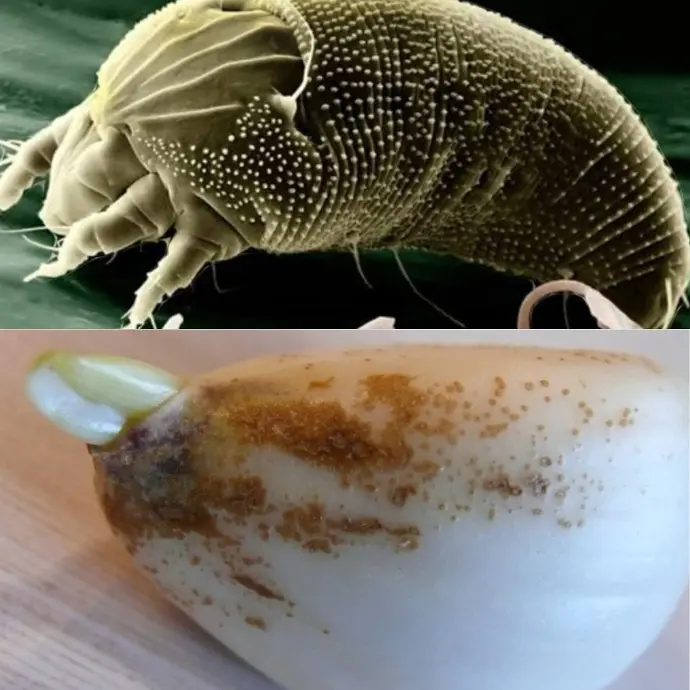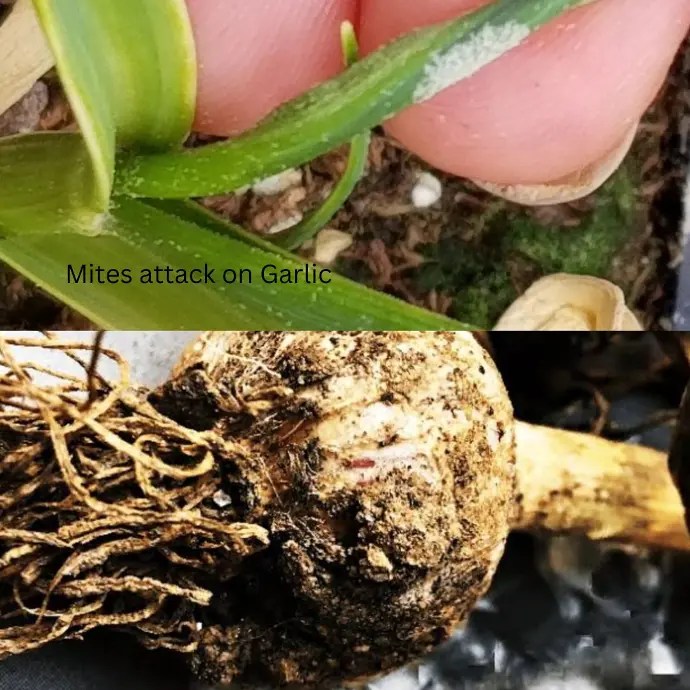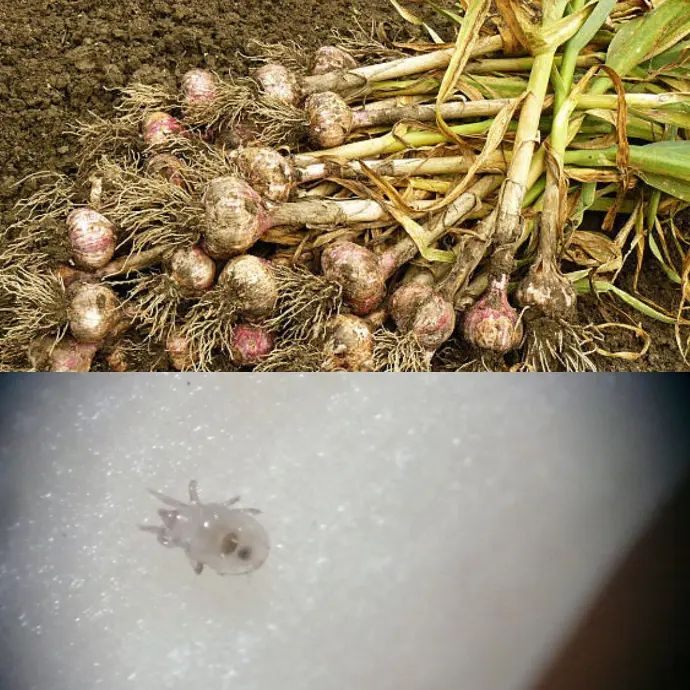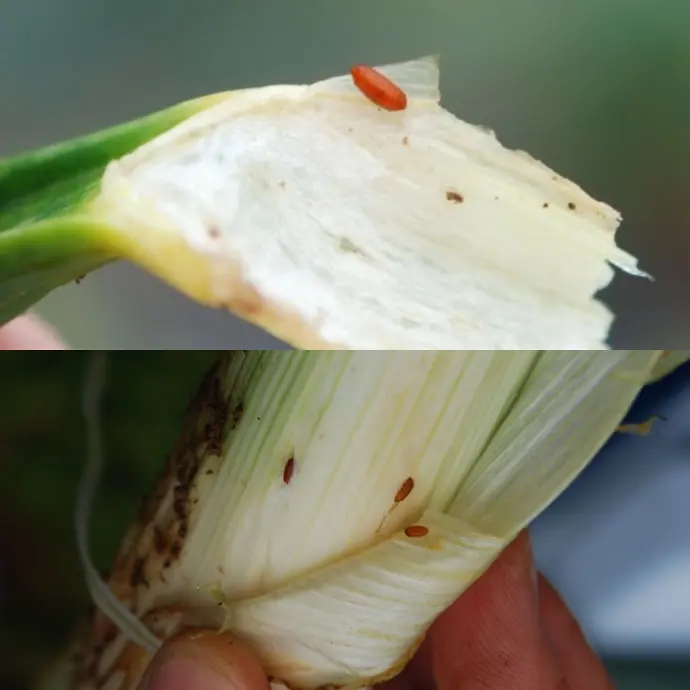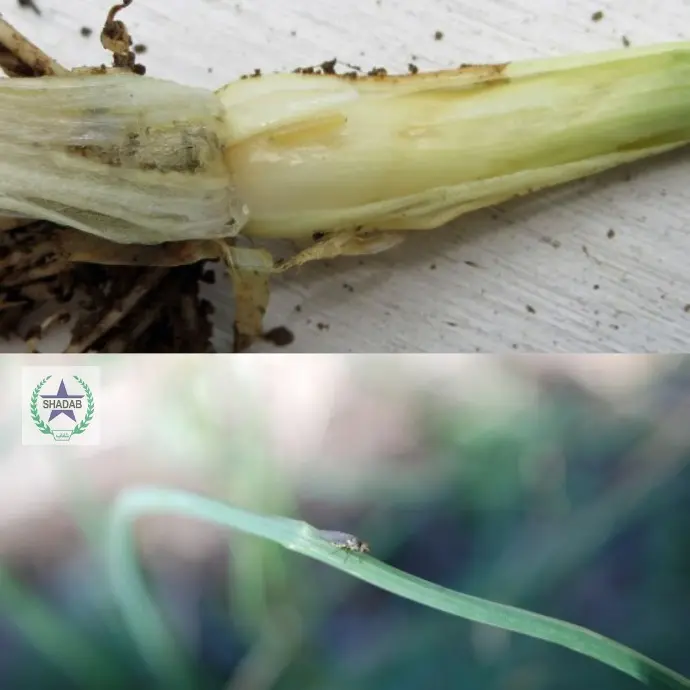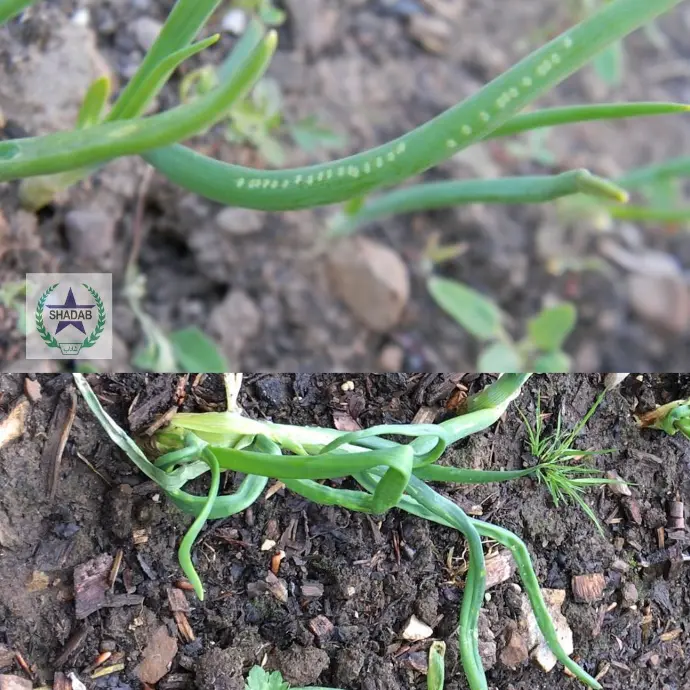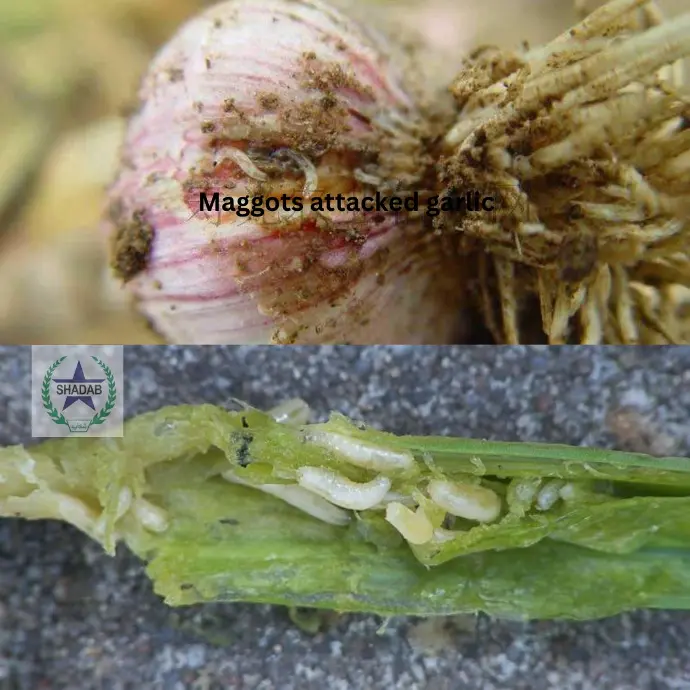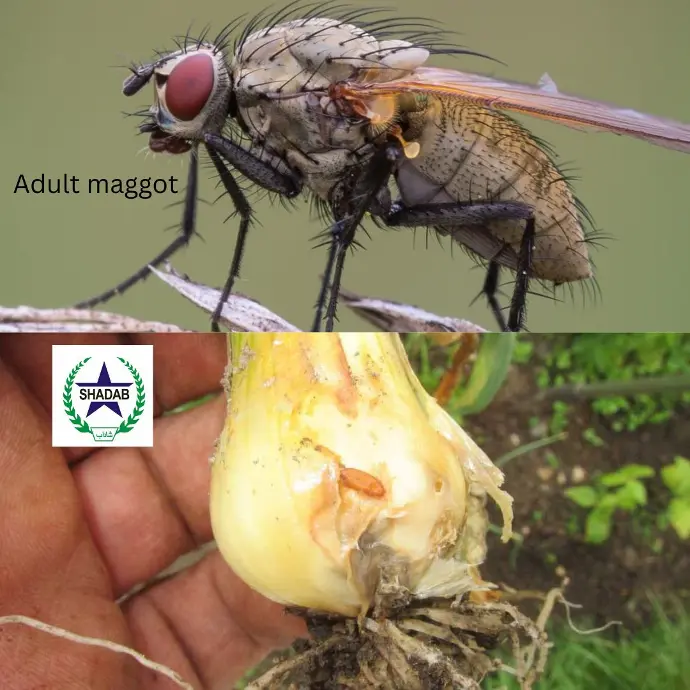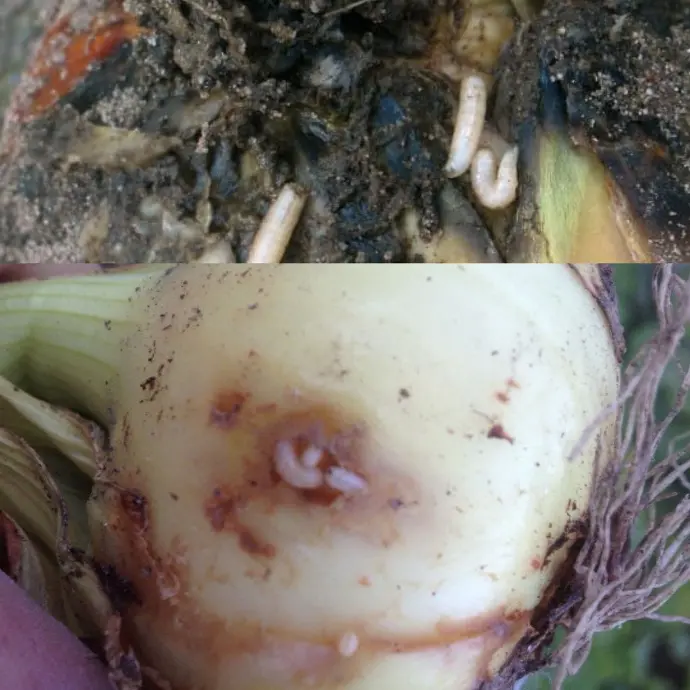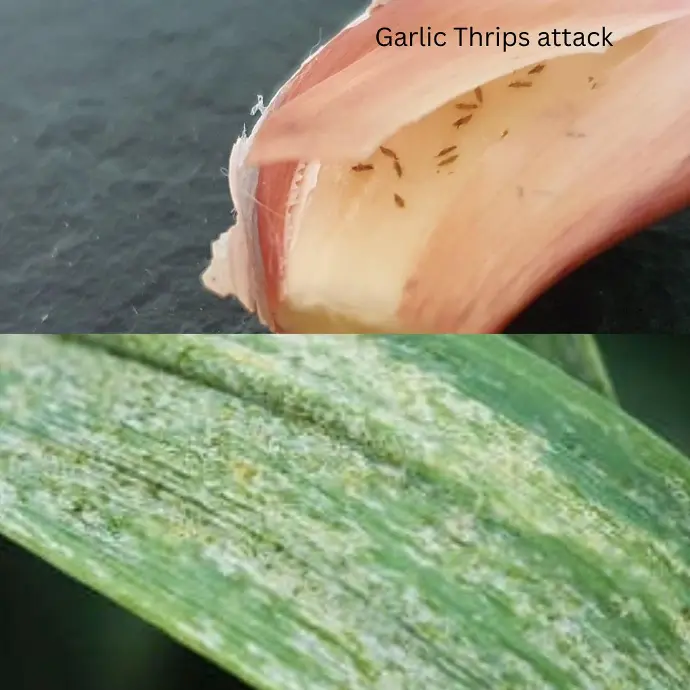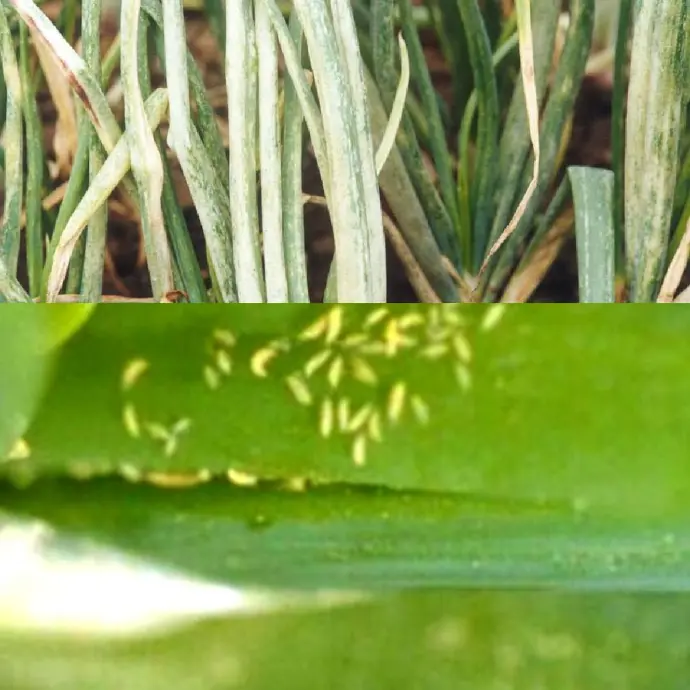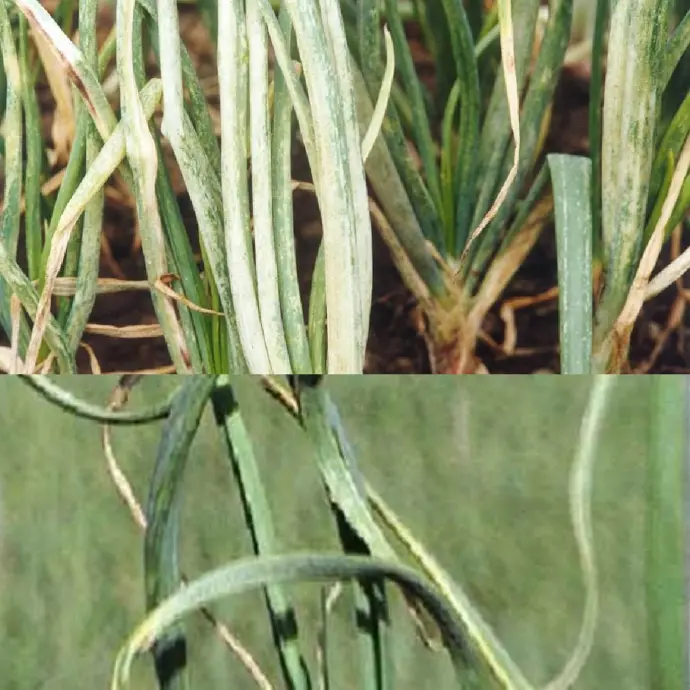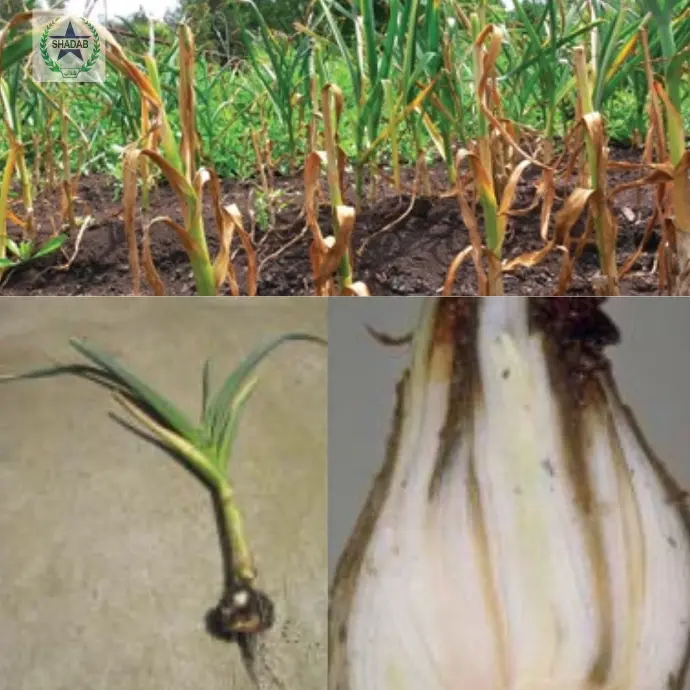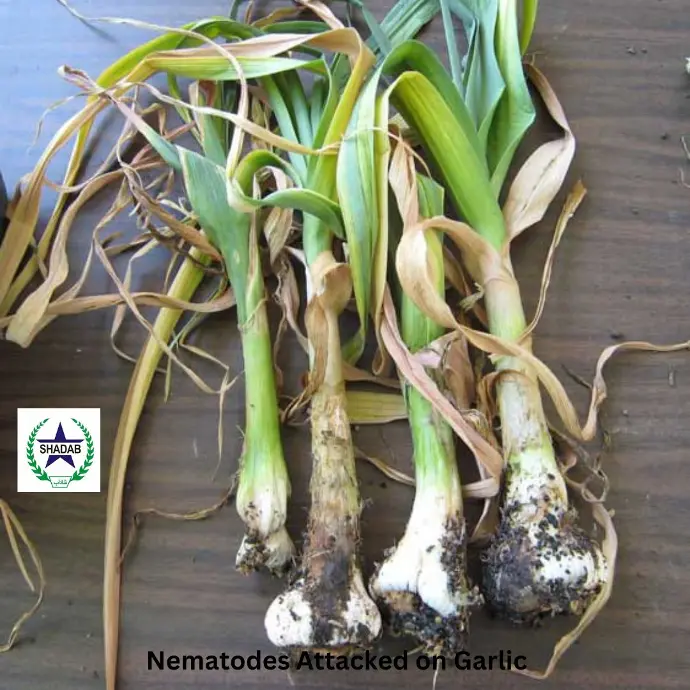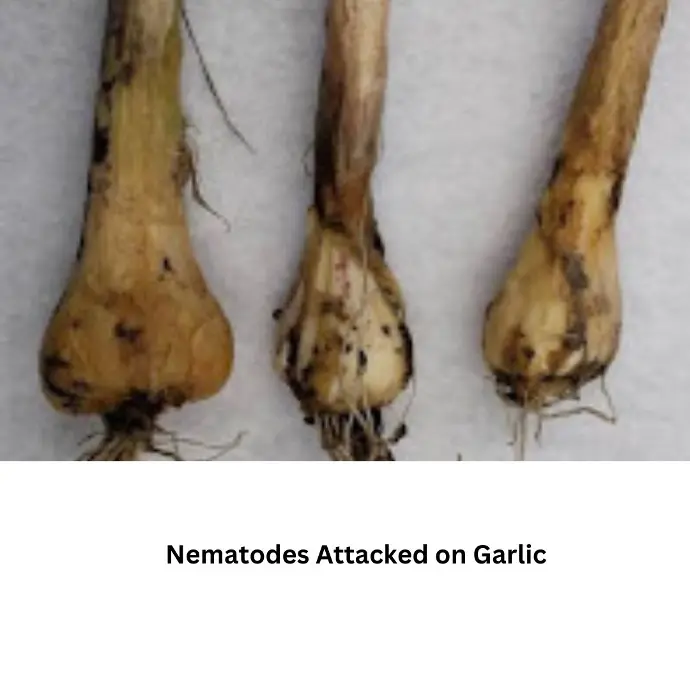PEST AND NEMATODES OF GARLIC
Pests Classification:
1-Bulb Mites
Bulb mites, specifically from the genera Rhizoglyphus and Tyrophagus, are notable pests affecting plant health. The presence of these mites is often indicated by symptoms such as stunted growth, diminished plant density, and the rotting of bulbs either in the soil or during storage. These pests are characterized by their cream-white, bulbous appearance, measuring less than 1 mm in length, and they resemble small pearls with legs.The damage inflicted by bulb mites can facilitate the entry of secondary pathogens, leading to bulb rot issues. To manage these pests effectively, it is advisable to avoid planting onion or garlic in the same area consecutively. Allowing the field to lie fallow will promote the complete decomposition of any remaining organic matter, which can serve as a habitat for mite populations. Additionally, treating garlic seed cloves with hot water before planting may contribute to a reduction in mite numbers.
بلب کے ذرات، خاص طور پر نسل کے Rhizoglyphus اور Tyrophagus سے، پودوں کی صحت کو متاثر کرنے والے قابل ذکر کیڑے ہیں۔ ان مائیٹس کی موجودگی اکثر علامات سے ظاہر ہوتی ہے جیسے کہ نشوونما میں کمی، پودوں کی کثافت میں کمی، اور بلب کا یا تو مٹی میں یا ذخیرہ کرنے کے دوران گلنا۔ ان کیڑوں کی خصوصیت ان کی کریم سفید، بلبس ظاہری شکل سے ہوتی ہے، جس کی لمبائی 1 ملی میٹر سے کم ہوتی ہے، اور وہ ٹانگوں کے ساتھ چھوٹے موتیوں سے مشابہت رکھتے ہیں۔ بلب کے ذرات سے پہنچنے والا نقصان ثانوی پیتھوجینز کے داخلے کو آسان بنا سکتا ہے، جس سے بلب سڑنے کے مسائل پیدا ہوتے ہیں۔ ان کیڑوں کو مؤثر طریقے سے سنبھالنے کے لیے، یہ مشورہ دیا جاتا ہے کہ پیاز یا لہسن کو لگاتار ایک ہی علاقے میں لگانے سے گریز کریں۔ کھیت کو گرنے کی اجازت دینے سے کسی بھی باقی ماندہ نامیاتی مادے کے مکمل گلنے کو فروغ ملے گا، جو کہ ذرات کی آبادی کے لیے مسکن کے طور پر کام کر سکتا ہے۔ مزید برآں، پودے لگانے سے پہلے لہسن کے بیجوں کے لونگ کو گرم پانی سے ٹریٹ کرنے سے کیڑوں کی تعداد میں کمی ہو سکتی ہے۔
2-Leaf miners Lyriomyza spp.
Symptoms of leaf miner infestation include the presence of thin, white, winding trails on the foliage. Severe damage may lead to the formation of white blotches and premature leaf drop, which can significantly impact crop yield. The adult leaf miner, characterized by its small black and yellow appearance, lays eggs within the leaf tissue. Once the larvae hatch, they begin to consume the interior of the leaf, causing further damage. The life cycle of the leaf miner is notably rapid, with mature larvae dropping to the soil to pupate, allowing the entire process to be completed in as little as two weeks under warm conditions. This insect can produce between seven to ten generations annually. Effective management strategies include inspecting transplants for any signs of leaf miner damage before planting and promptly removing plants from the soil after harvest. Insecticides should only be applied when leaf miner damage is confirmed, as indiscriminate spraying can also harm their natural predators.
پتوں کی کھدائی کے انفیکشن کی علامات میں پتلی، سفید، سمیٹنے والی پگڈنڈیوں کی پتیوں پر موجودگی شامل ہے۔ شدید نقصان سفید دھبے اور وقت سے پہلے پتے کے گرنے کا باعث بن سکتا ہے، جو فصل کی پیداوار کو نمایاں طور پر متاثر کر سکتا ہے۔ بالغ پتوں کی کان کنی، اس کی چھوٹی سیاہ اور پیلی شکل کی خصوصیت ہے، پتی کے ٹشو کے اندر انڈے دیتی ہے۔ لاروا نکلنے کے بعد، وہ پتے کے اندرونی حصے کو استعمال کرنا شروع کر دیتے ہیں، جس سے مزید نقصان ہوتا ہے۔ پتوں کی کھدائی کرنے والے کا لائف سائیکل خاص طور پر تیز ہوتا ہے، جس میں پختہ لاروا پیوپیٹ کرنے کے لیے مٹی میں گر جاتا ہے، جس سے گرم حالات میں پورے عمل کو کم از کم دو ہفتوں میں مکمل کیا جا سکتا ہے۔ یہ کیڑا سالانہ سات سے دس نسلیں پیدا کر سکتا ہے۔ مؤثر انتظامی حکمت عملیوں میں پودے لگانے سے پہلے پتوں کی کھدائی کے نقصان کی علامات کے لیے ٹرانسپلانٹ کا معائنہ کرنا اور فصل کی کٹائی کے بعد فوری طور پر مٹی سے پودوں کو ہٹانا شامل ہے۔ کیڑے مار دوا صرف اس وقت لگائی جانی چاہیے جب پتوں کی کھدائی کے نقصان کی تصدیق ہو جائے، کیونکہ اندھا دھند چھڑکاو ان کے قدرتی شکاریوں کو بھی نقصان پہنچا سکتا ہے۔
3-Maggots of Garlic
The onion maggot, scientifically known as Delia antiqua, presents several symptoms that can significantly affect onion crops. Seedlings may exhibit stunted growth or wilting, and if an attempt is made to uproot them, they often break at the soil line. In cases where the infestation occurs during the bulbing stage, the resulting bulbs may become deformed and more vulnerable to rot during storage after harvest. The adult onion maggot is a greyish fly that deposits white, elongated eggs at the base of the plants. Upon hatching, the larvae are small and white, burrowing into the plant tissue, with mature larvae reaching approximately 1 cm (0.4 in) in length and equipped with feeding hooks. The primary cause of this issue is the insect itself, with female onion maggots capable of laying several hundred eggs throughout their lifespan of 2 to 4 weeks. These insects survive the winter as pupae within the soil. Effective management of onion maggots largely depends on maintaining good sanitation practices. It is essential to remove all onion bulbs at the end of the growing season, as the absence of a food source will lead to the death of the maggots. Commercial onion producers often resort to the application of suitable granular insecticides, and in some instances, insecticide sprays may also be necessary. For home gardeners, it is advisable to eliminate any wild onion and chive plants, as they can serve as a source of infection. Additionally, employing floating row covers can provide protection for the plants and deter female flies from laying eggs in the vicinity.
پیاز کا میگٹ، سائنسی طور پر ڈیلیا اینٹیکا کے نام سے جانا جاتا ہے، کئی علامات پیش کرتا ہے جو پیاز کی فصلوں کو نمایاں طور پر متاثر کر سکتا ہے۔ پودوں کی نشوونما رک جاتی ہے یا مرجھائی جاتی ہے، اور اگر انہیں اکھاڑ پھینکنے کی کوشش کی جاتی ہے، تو وہ اکثر مٹی کی لکیر پر ٹوٹ جاتے ہیں۔ ان صورتوں میں جہاں بلبنگ کے مرحلے کے دوران انفیکشن ہوتا ہے، نتیجے میں بلب خراب ہو سکتے ہیں اور کٹائی کے بعد ذخیرہ کرنے کے دوران سڑنے کا زیادہ خطرہ بن سکتے ہیں۔ بالغ پیاز کی مکھی ایک سرمئی مکھی ہے جو پودوں کی بنیاد پر سفید، لمبے انڈے جمع کرتی ہے۔ انڈوں سے نکلنے پر، لاروا چھوٹے اور سفید ہوتے ہیں، پودے کے بافتوں میں دب جاتے ہیں، بالغ لاروا تقریباً 1 سینٹی میٹر (0.4 انچ) لمبائی تک پہنچتا ہے اور کھانا کھلانے کے ہکس سے لیس ہوتا ہے۔ اس مسئلے کی بنیادی وجہ خود کیڑے ہیں، جس میں پیاز کی مادہ 2 سے 4 ہفتوں کی عمر میں کئی سو انڈے دینے کی صلاحیت رکھتی ہے۔ یہ کیڑے سردیوں میں مٹی کے اندر pupae کے طور پر زندہ رہتے ہیں۔ پیاز میگوٹس کا موثر انتظام زیادہ تر صفائی کے اچھے طریقوں کو برقرار رکھنے پر منحصر ہے۔ بڑھتے ہوئے موسم کے اختتام پر پیاز کے تمام بلبوں کو ہٹا دینا ضروری ہے، کیونکہ کھانے کے ذرائع کی عدم موجودگی میگوٹس کی موت کا باعث بنے گی۔ تجارتی پیاز پیدا کرنے والے اکثر مناسب دانے دار کیڑے مار ادویات کے استعمال کا سہارا لیتے ہیں، اور بعض صورتوں میں، کیڑے مار دوا کے سپرے بھی ضروری ہو سکتے ہیں۔ گھریلو باغبانوں کے لیے یہ مشورہ دیا جاتا ہے کہ کسی بھی جنگلی پیاز اور چائیو کے پودوں کو ختم کر دیا جائے، کیونکہ وہ انفیکشن کا ذریعہ بن سکتے ہیں۔ مزید برآں، تیرتے ہوئے قطاروں کے کور کا استعمال پودوں کو تحفظ فراہم کر سکتا ہے اور مادہ مکھیوں کو آس پاس کے علاقے میں انڈے دینے سے روک سکتا ہے۔
4-Garlic Thrips:
Thrips, specifically Onion thrips (Thrips tabaci) and Western flower thrips (Frankliniella occidentalis), are small insects that can cause significant damage to plants. The symptoms of infestation include discolored and distorted tissue, as well as scarring on leaves. Severely affected plants may exhibit a silvery sheen. Adult thrips measure approximately 1.5 mm in length and possess a slender body, making them best observed with a hand lens. Their coloration ranges from pale yellow to light brown, while the nymphs are smaller and lighter in hue.The presence of onion thrips and western flower thrips is primarily due to their broad host range, allowing them to be introduced to garlic from various other plants. Effective management strategies include utilizing natural predators such as certain species of predatory mites, pirate bugs, and lacewings. It is advisable to avoid planting onions near grain fields, as these areas can lead to increased thrips populations during the spring. Additionally, implementing overhead irrigation may help mitigate thrips numbers, and the timely application of suitable insecticides at the first indication of damage is recommended for effective control.
تھرپس، خاص طور پر پیاز کے تھرپس (تھریپس ٹیبیکی) اور مغربی پھولوں کے تھرپس (فرینکلینیلا اوکسیڈینٹلس)، چھوٹے کیڑے ہیں جو پودوں کو کافی نقصان پہنچا سکتے ہیں۔ انفیکشن کی علامات میں رنگین اور مسخ شدہ بافتوں کے ساتھ ساتھ پتوں پر داغ بھی شامل ہیں۔ شدید متاثرہ پودے چاندی کی چمک دکھا سکتے ہیں۔ بالغ تھرپس کی لمبائی تقریباً 1.5 ملی میٹر ہوتی ہے اور ان کا جسم پتلا ہوتا ہے، جس کی وجہ سے وہ ہاتھ کے عینک سے بہترین مشاہدہ کرتے ہیں۔ ان کی رنگت ہلکے پیلے سے ہلکے بھورے تک ہوتی ہے، جب کہ اپسرا رنگت میں چھوٹے اور ہلکے ہوتے ہیں۔ پیاز کے تھرپس اور مغربی پھولوں کے تھرپس کی موجودگی بنیادی طور پر ان کی وسیع میزبان رینج کی وجہ سے ہوتی ہے، جس کی وجہ سے وہ مختلف دیگر پودوں سے لہسن سے متعارف ہو سکتے ہیں۔ مؤثر انتظامی حکمت عملیوں میں قدرتی شکاریوں کا استعمال شامل ہے جیسے کہ شکاری ذرات کی کچھ مخصوص نسلیں، سمندری ڈاکو کیڑے، اور لیس ونگ۔ اناج کے کھیتوں کے قریب پیاز لگانے سے گریز کرنے کا مشورہ دیا جاتا ہے، کیونکہ یہ علاقے موسم بہار کے دوران تھرپس کی آبادی میں اضافے کا باعث بن سکتے ہیں۔ مزید برآں، اوور ہیڈ آبپاشی کو نافذ کرنے سے تھرپس کی تعداد کو کم کرنے میں مدد مل سکتی ہے، اور مؤثر کنٹرول کے لیے نقصان کے پہلے اشارے پر مناسب کیڑے مار ادویات کے بروقت استعمال کی سفارش کی جاتی ہے۔
Garlic Nematodes
Lesion nematode, scientifically known as Pratylenchus penetrans, is characterized by several distinct symptoms. Affected plants often exhibit stunted growth, and their root systems typically lack the fine roots necessary for optimal nutrient absorption. Additionally, the roots may display round or irregular lesions, which are indicative of nematode activity.
The primary cause of these symptoms is the lesion nematode itself. This particular nematode is notable for its extensive host range, making it one of the most versatile among nematodes. It infiltrates the plant through the root epidermis, where it feeds on the cellular contents. To manage this pest, hot water dips can be employed to mitigate nematode populations in bulbs. However, crop rotation is generally ineffective against lesion nematodes due to their ability to thrive on a wide variety of host plants.
Lesion nematode، جو سائنسی طور پر Pratylenchus penetrans کے نام سے جانا جاتا ہے، کئی الگ الگ علامات کی خصوصیت رکھتا ہے۔ متاثرہ پودے اکثر رکی ہوئی نشوونما کو ظاہر کرتے ہیں، اور ان کے جڑوں کے نظام میں عام طور پر غذائی اجزاء کے زیادہ سے زیادہ جذب کے لیے ضروری جڑوں کی کمی ہوتی ہے۔ مزید برآں، جڑیں گول یا بے قاعدہ گھاووں کو ظاہر کر سکتی ہیں، جو نیماٹوڈ کی سرگرمی کا اشارہ ہیں۔
ان علامات کی بنیادی وجہ نمیٹوڈ خود گھاو ہے۔ یہ مخصوص نیماٹوڈ اپنی وسیع میزبان رینج کے لیے قابل ذکر ہے، جو اسے نیماٹوڈس میں سب سے زیادہ ورسٹائل بناتا ہے۔ یہ جڑ کے ایپیڈرمس کے ذریعے پودے میں گھس جاتا ہے، جہاں یہ سیلولر مواد کو کھاتا ہے۔ اس کیڑوں کو سنبھالنے کے لیے، بلبوں میں نیماٹوڈ کی آبادی کو کم کرنے کے لیے گرم پانی کے ڈبوں کا استعمال کیا جا سکتا ہے۔ تاہم، فصل کی گردش عام طور پر گھاووں والے نیماٹوڈز کے خلاف غیر موثر ہوتی ہے کیونکہ ان کی میزبان پودوں کی وسیع اقسام پر پھلنے پھولنے کی صلاحیت ہوتی ہے۔
